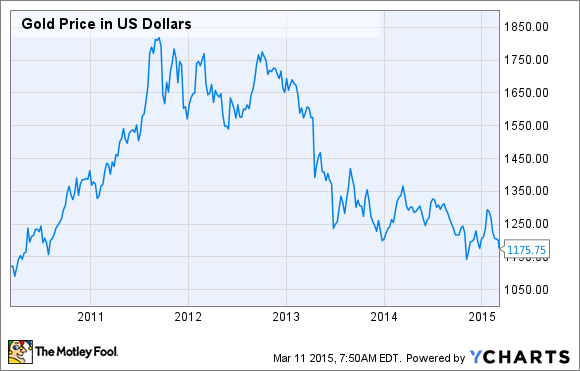Newmont Mining Corporation (NEM 0.49%) is one of the world's largest gold miners. That's a tough place to be right now, because gold is well off its recent highs. But the company has been managing what it can to keep itself financially and operationally strong. Here's what the company is doing to stay alive.
Nothing special here
The thing about gold is that it's a commodity. Copper, another metal the company mines, is also a commodity, but it has less impact on the top line. One ounce of either is basically the same as another ounce. So Newmont has no way to differentiate its products in the market. It has to take whatever price the market is willing to give based on supply and demand.
Gold Price in U.S. Dollars data by YCharts.
A few years ago, the price of gold was around $1,800 an ounce. More recently, it's been in the range of $1,100 to $1,200 an ounce. There's a big difference between those two numbers because mining is expensive, and the costs are pretty static. For example, Newmont's all-in sustaining costs (a measure of how much it costs to pull gold from the ground) for mining an ounce of gold were around $1,002 last year. Clearly, Newmont makes a lot more money when gold is expensive than it does when gold is less expensive. And if gold were to fall below the company's costs, there's not much it could do about it other than close more expensive mines.
And the cost of mining is pretty hard to change. For example, while Newmont was able to trim its all-in sustaining costs by around 10% last year, it's goal is to roughly maintain its costs at current levels for the next couple of years. That means its done about all it can to reduce costs for now, and the price of gold will be the bigger determinant of sales and, more importantly, earnings.
Offsetting the decline
To make matters worse, once Newmont, or any miner for that matter, pulls an ounce of gold from the ground, it's gone. It's one less ounce Newmont can mine in the future. This is called depletion, and the only way to offset depletion is to find more gold to mine. Moreover, as mines age, they tend to become less productive (and more costly). So Newmont is constantly dealing with the problem of replacing the gold it can mine in the future and offsetting declining production at older mines.
Newmont has a series of smaller projects at or near existing mines planned to come online over the next couple of years. The giant miner hopes these projects will keep production roughly flat. That may not sound like such a great achievement, but investment expenses have to be carefully considered with gold hovering around recent prices. That's why Newmont is focusing on projects that have a high likelihood of achieving their goals. That's much safer, and far less costly, than undertaking the construction of a raft of brand-new mines in distant locales.

Source: Andrzej Barabasz, via Wikimedia Commons.
If gold prices were higher and margins were fatter, taking on riskier development projects would make more financial sense. Right now, that's just not the case. And even if gold were more dear, the company's previous management team went through a period where it made costly investment decisions that didn't pan out as expected. For example, the company's Minas Conga project has been mired in politics and public opposition in Peru for years. That project is pretty much on hold today. So Newmont's current leadership is likely to be cautious about expansion even if gold prices rally, and justifiably so.
Waiting for gold
At the end of the day, Newmont isn't much different from other gold miners. They all have to deal with the impact of an undifferentiated product subject to often quick and volatile price swings. So, Newmont's goal today of basically maintaining where it is isn't a bad thing, or unusual. However, it means gold will have to move higher before there's any meaningful change in the company's outlook. That's not good or bad -- it just is.







